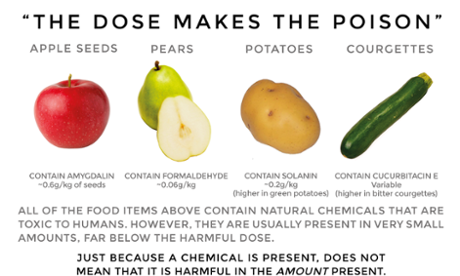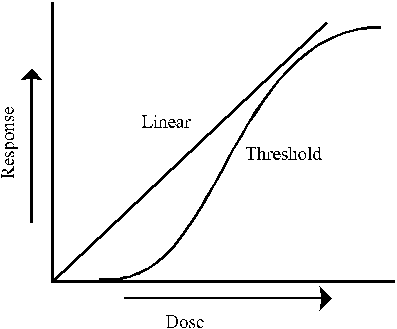| Raw for Beauty.com |
Recent concerns regarding the toxicity of food products, like ones made by Food-Babe minded folks discussing chemicals in pumpkin spice lattes, often fail to mention the dose of the questionable compound, and when this is pointed out, they retort that there is a lack of long-term data on the topic in humans and invoke the precautionary principle.
 |
| mercola.com |
 |
| Sense About Science |
 |
| Environmental Working Group. |
 |
| Carcinogenicity data for compounds found naturally in foods. Many occur at levels that are relevant to their contents in food. |
My general point is that everything is toxic at a specific dose. How do we determine that dose though?
When people think of toxicity, they generally think of linear or threshold models.This is the most common model and how people that I regularly encounter think of toxicity - either a chemical is always toxic and keeps getting more toxic as you increase the dose, or low amounts pose no risk but at a certain threshold, the chemical becomes toxic.
While this is certainly a valid model, it does not apply universally to 'chemicals'. As a nutritional scientist, I can't rely on this model. When you look at the recommendations for nutrients, they have a U-shaped curve:
This should make intuitive sense - ingesting too little of a nutrient doesn't provide the necessary amounts for health, but ingesting too much leads to negative outcomes. Too little vitamin A during pregnancy can leave your offspring at increased risk of morbidity/mortality from infections due to hypovitaminosis A, but too much vitamin A (retinol) can be teratogenic. Nutrients don'ts act in the linear or threshold manners.
Another response trend also exists- the J-shape. This is known as the Hormetic Dose-Response Model. It is an emerging model that has been demonstrated to be even more common than the simpler threshold dose-response model (7,8).
The hormetic model essentially shows that low doses are beneficial, and as the dose increases, the compound becomes toxic. Examples of this can be found all over the toxicology literature. Low amounts of methylmercury have been shown to improve hatching success of eggs from mallards (9). In the free radical biology field, a concept known as mitohormesis is emerging (10), and forcing scientists to re-think the supposed detrimental effects attributed to oxidative stress. This thinking is being re-applied to a number of concepts in nutrition (11,12), including vitamin and mineral intake, energy restriction, acrylamide, pesticides (both natural and synthetic), and alcohol. Low levels of both man-made and naturally occurring chemicals may indeed have beneficial effects for humans.
I should note that hormesis, as it has been applied to BPA exposure, has caused some controversy, as some have suggested that the hormetic effect can be inverted, with low doses causing negative effects not seen at high doses (13,14); These studies have lacked repeatability and might be due to the strains of rats used, as better designed studies have not shown this trend (15,16).
What I hope to demonstrate here is not that we shouldn't be concerned about any chemicals in our environment - I would hope you don't go drinking DDT or super-heating your plastics to get a bit more BPA in - but rather that when someone tells you something is toxic, your next question should be: at what dose and in what model? Do low levels have a negative effect? Might they have a positive effect? And even more importantly, does the person telling me these things are toxic have a knowledge of basic toxicological principles?
Also please note that I'm in no way defending or advising regular consumption of Pumpkin Spice lattes. At 380kcals/16oz, they're a nice seasonal treat to enjoy on occasion, but lack many essential nutrients and fiber.
1. http://www.ncbi.nlm.nih.gov/pubmed/9677052
2. http://en.wikipedia.org/wiki/List_of_IARC_Group_2B_carcinogens
3. http://www.ncbi.nlm.nih.gov/pubmed/21075160
4.http://www.ncbi.nlm.nih.gov/pubmed/19059451
5. http://www.ncbi.nlm.nih.gov/pmc/articles/PMC3135239
6. http://www.pnas.org/content/87/19/7777.full.pdf
7. http://toxsci.oxfordjournals.org/content/71/2/246.full
8. http://www.ncbi.nlm.nih.gov/pmc/articles/PMC1299203/
9. http://www.ncbi.nlm.nih.gov/pubmed/20821490
10. http://www.sciencedirect.com/science/article/pii/S0531556510001282
11. http://www.ncbi.nlm.nih.gov/pmc/articles/PMC2836150/
12. http://www.nature.com/ejcn/journal/v61/n2/abs/1602507a.html
13. http://cancerres.aacrjournals.org/content/66/11/5624.abstract
14. http://www.ncbi.nlm.nih.gov/pubmed/16235731
15. http://toxsci.oxfordjournals.org/content/114/1/1.full
16. http://www.ncbi.nlm.nih.gov/pubmed/19864446
17. http://www.cof.orst.edu/cof/teach/agbio2010/Other%20Readings/Organic%20Food%20Rev%20Inst%20Food%20Technol%20Dec%202006.pdf



Good stuff for scientists. Those who prefer to avoid graphics, look at the top 10 most toxic foods. Avoiding them can be life changing for those who are adversely effected.
ReplyDelete